Africa is a wild and diverse continent that promises nothing short of adventure. It’s the second largest continent, made up of 54 countries, and presents travelers with a host of wonderful experiences, as well as a few challenges.
One of the biggest challenges about traveling in Africa is knowing how to get around.
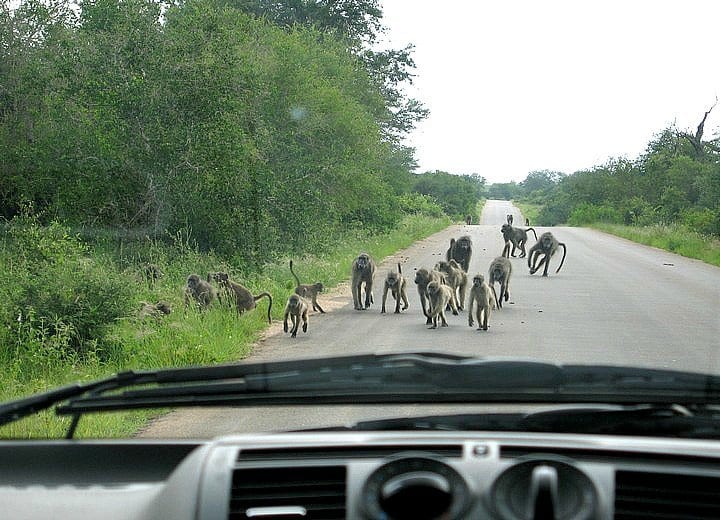
We explored East and South Africa on a five-month backpacking adventure, and found there were many forms of transport to explore the continent with.
Getting around East and South Africa is rough, but it’s cheap, and it will provide you with some of your most entertaining stories.
In this guide, we share how to get around East and South Africa and the different modes of transport you can take.
There are many transportation options to suit each travellers budget, desired experiences and comfort levels, which we’ll go into below.
How To Travel Africa: Getting Around East and South Africa
Below are the main ways to get around Africa.
Guided Tour
For those travellers who feels a little intimidated about backpacking Africa independently, or a short on time and want to be spared the hassle, there are organized overland safari tours that make traveling in Africa easy.
Craig, and I decided not to travel Africa in this way, although we ran into a lot of these overlander trucks through Africa and were given quite an insight into how they operated.
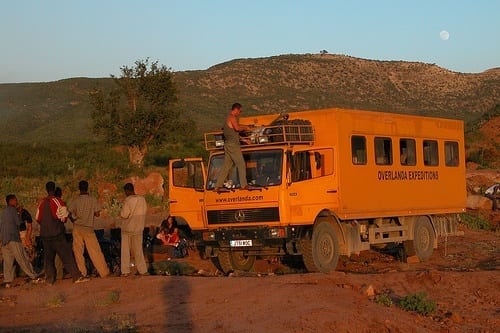
We wanted to travel slower through each area, and have a lot more contact with the local people, but we can see the appeal for a tour – Africa can feel huge and overwhelming.
Overland safari tours will be more expensive than independent travel, but costs usually cover meals, transport, and accommodation.
Travelling Africa independently for 5 months cost us $7,000 total, and we visited several countries.
If you’re short on time, or only have one month, then we highly recommend this GAdventures Tour from Nairobi to South Africa, which covers the top places to visit in Africa such as Victoria Falls, the Okavango Delta, Chobe National Park, South Luangwa National Park, Lake Malawi, Zanzibar and a trip to the Serengeti.
Globus Tours
We have also traveled with the Globus family brand of tours on several occasions now and have loved them. They offer a variety of tours including budget and more luxury. Here are some of their Africa tours. Don’t forget our exclusive discount code in the blue box below.
GLOBUS DISCOUNT JUST FOR YOU!
We’ve secured an exclusive yTravel discount: Save $100 per person on select 2024 Globus and Avalon Waterway Vacations. Use the code: YTRAVEL when booking online at the Globus, Cosmos, and Avalon Waterways websites, by calling Globus and Avalon Waterways directly, or booking with a preferred Travel Advisor. Terms & Conditions.
Baz Bus
The Baz Bus is a hop on, hop off style transportation company organized to help backpackers and travelers get around South Africa in comfort.
It has designated travel route that follows the backpacking trail, taking you to the most popular destinations and popular things to do in South Africa.
You can choose the route you want, and the bust will pick you up and drop you off at your selected hostel.
Tickets can be purchased for a specific number of days, or more open-ended fleixible tickets are available.

The Baz bus experience
Prices for the Baz Bus range from USD $200 to $500.
After 4 months of traveling around Africa using public transport, I welcomed the Baz Bus ‘luxury’ experience with open arms.
I used it for the last two weeks in South Africa to travel from Durban to Johannesburg via Zululand, Swaziland and Kruger National Park.
Getting picked up and dropped off at my hostel door, spreading myself out on my own spacious seat while I watched videos and swapped stories with other travelers, was pure bliss and so worth the extra expense.
It’s also a safer way to travel for solo travelers in South Africa who don’t want to take a group tour.
Public Buses
There wasn’t a bus journey we went on in Africa that did not involve a laughter and conversation with the locals, having a child thrown on your lap, a neighboring rooster dangerously pecking around your head, a protective mother figure curing your motion sickness with matchsticks, or dramas such as punctured tires, highway roadside ablutions and bus drivers leaving behind those who did not get back from the toilet quick enough.
This is Africa and what better way to experience it.
Public buses (USD$3-$32) are usually taken for longer journeys and across borders where there is a good network of sealed roads.
The buses are generally comfortable, safe and spacious.
When traveling around East African countries such as Kenya, Rwanda, Tanzania, Zambia and Zimbabwe, you’ll find there are fewer public buses available than there are in North African countries such as Tunisia, Morocco and Egypt.
This is because they are less developed and have fewer vehicles on the road in general.
These places have fewer or no sealed roads and will have ancient buses that frequently break down, and are crowded.
A step up from the local public buses is the Intercape, the largest privately owned intercity bus service in Southern Africa.
Think modern coach service with reclining seats and restrooms. We experienced the comfort of this from Cape Town to Durban…ahhh!
Mini Vans
I thought Asians knew how to fill a mini-van, but then I went to Africa. The mini vans in Asia are quite spacious in comparison to mini vans in Africa.
Africa is the place that sets the outer limits as to how many people can be transported at once in a vehicle.
Just when you think they couldn’t possibly fit another person in, they have them stand on the window sill outside the van.
I questioned my sanity, every time I rode in a mini-van, and spent the majority of the journey eyes closed to avoid seeing the drivers careen around mountainous corners at speeds of over 80km/h, overtaking anything from bikes to livestock trucks.
Travel in Africa, like this, is not for the faint hearted. Africa is poor; the drivers want to overfill the beat-up, rusty van and go as fast as they can in order to make more money.
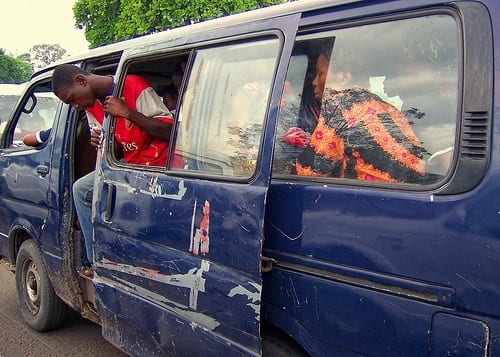
Mini-vans are a very cheap way to get around, and are usually taken for up to 6 hour journeys within a country (usually around USD$1-$10).
They don’t leave until they are full, so jump on one that looks ready to go and avoid sitting in the front seat, commonly referred to as the ‘death seat.’
Of course there is more room!
Pick Ups
Pickups are cheap (usually not much more than USD$2) and tend to go a lot slower, traveling more on the smaller rural or village roads. I appreciated pickup travel a lot more than mini vans.
Even though I was hanging out in the pickup tray with bags of rice and potatoes, bicycles, and generally the whole village, I still felt a lot safer.
Traveling Africa in this way is extremely uncomfortable, but the communal aspect of it makes up for this.
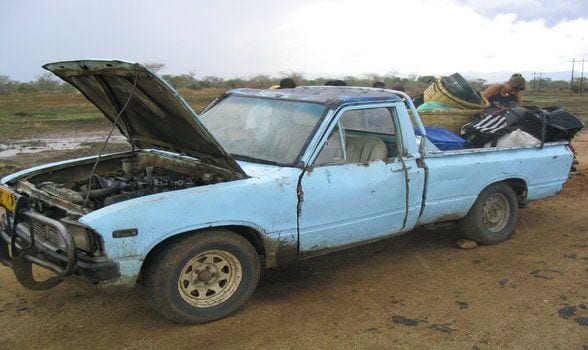
A local African took me under his wing, as his muzungu (white person), on an 8 hour, 97km pickup trip to see the gorillas in Uganda.
No one was to touch me or make me uncomfortable; he even threatened to beat two handcuffed prisoners for accidentally sitting on my shoulder.
We sat under a blue tarp as rain pelted down on our drive through treacherous mountain passes.
Benson rescued me several times from sliding off the side of the truck to certain death below. You can always count on African pickups to give you memories like this.
We share more about this experience in this podcast on Amazing adventures to have in Uganda.
Hitchhiking
Hitchhiking is something that would turn most people’s blood to ice, especially with the thought of doing it in Africa.
It can be a relatively safe and cheap way to get around East and South Africa, and it can also be incredibly dangerous.
More people tend to hitchhike through Namibia and South Africa than any other East African country, but we wouldn’t recommend it unless there is no other way.
Hitchhiking can be free, although many times you will be expected to leave a small tip, and you have to be able to judge each situation. It is always a good idea to ask how much up front.
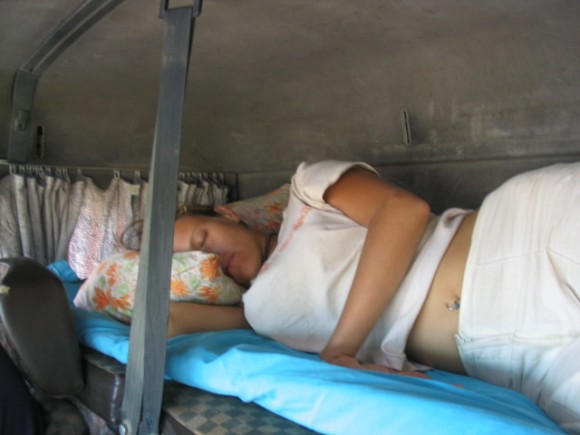
Accommodations and internet message boards often have notices for those seeking rides, in return for the sharing of fuel costs. This is much safer than flagging someone down on the side of the road.
If you hitch from the side of the road it’s best to wave your hand up and down to flag a lift, as sticking out your thumb is considered a rude gesture in Africa.
Craig and I hitchhiked from Namibia to South Africa, only because other transport options were limited.
A Namibian trucker, for a small tip, drove us halfway, sharing stories with Craig about Namibian life while I slept comfortably in his bed.
Chinese students drove us the remainder of the way to Cape Town, for the sharing of fuel prices and stories of life in South Africa as a Chinese student.
Train
Although not a common form of transportation in East and South Africa, there will be times when the opportunity for train travel should be taken as it is a pleasantly relaxing, cultural experience.
You can travel most of Zimbabwe by train, using the National Railways of Zimbabwe. There is also a famous route from Johannesburg to Victoria Falls, but this is a luxury train and quite expensive.
Cruising through game reserves and seeing giraffe, lion, elephant, buffalo, leopard, wildebeest and zebra from my sleeper class cabin window was a surreal experience.
It was a treat to pick up passengers from small African towns and have goods hawked at our windows while children raced up to smile broadly and wave at the passing Muzungus.
Usually with travel in Africa you are squashed in like sardines, but if you pay for the higher class ticket (USD$20-$30) you will have your own sleeping cabin, giving you the space and freedom to walk around and appreciate African travel.
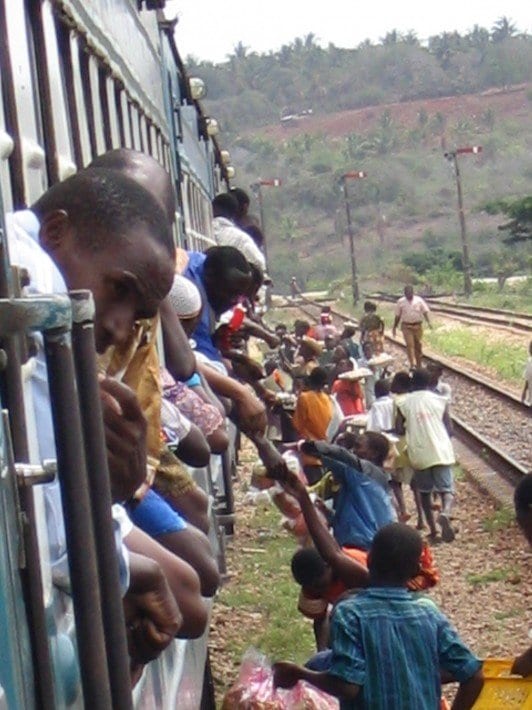
Car Hire
If you are not doing game drives in the Game Reserves, then leave room in your Africa travel budget for car hire.
There is no other way to view the wildlife and the natural wonders of Africa, and let’s face it this is one of your main reasons for coming to this beautiful continent.
Be clear on where the best viewing areas and safari camps are for your chosen game parks and plan accordingly so you can cut down on mileage and fuel expenses.
Car hire can be expensive but can work out to be a more cost-effective way to go on safari and tour certain regions of Africa. Check out DiscoverCars.com for the best competitive rates and excellent customer service.
We hired cars for safaris in Namibia and South Africa and to experience the beautiful Garden Route, a popular and scenic stretch off the coast of South Africa.
Car hire in South Africa can be found for as cheap as $30 a day, especially if you book online in advance.
In other parts of Africa it ranges from $75- $100 a day. Be careful of where you have to pick up your vehicle from.
If it is too far from the safari park you will have to allow for extra mileage and fuel expenses.
If you are planning on long term travel in Africa you may even consider buying your own 4WD to tour the continent in.
South Africa would be the best option for purchase, or a departing traveler ready to sell up.
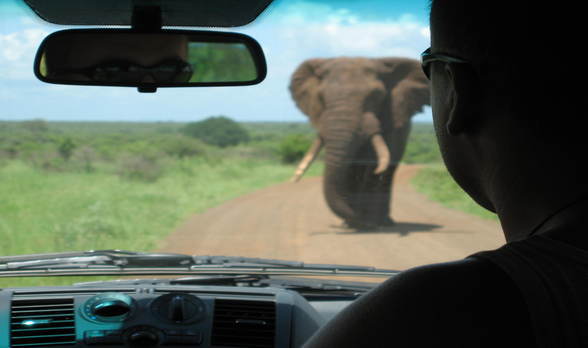
Getting around East and South Africa can be done really cheaply if planned well. Carefully consider your budget and safety interests for getting around Africa.
While public transport is cheap and authentic, it is uncomfortable and less safe. Hiring or buying a car is the more expensive option, but will give you greater freedom.
Overland Safari tours will be expensive and less authentic but will give you an all inclusive package and a greater sense of safety.
Final Thoughts
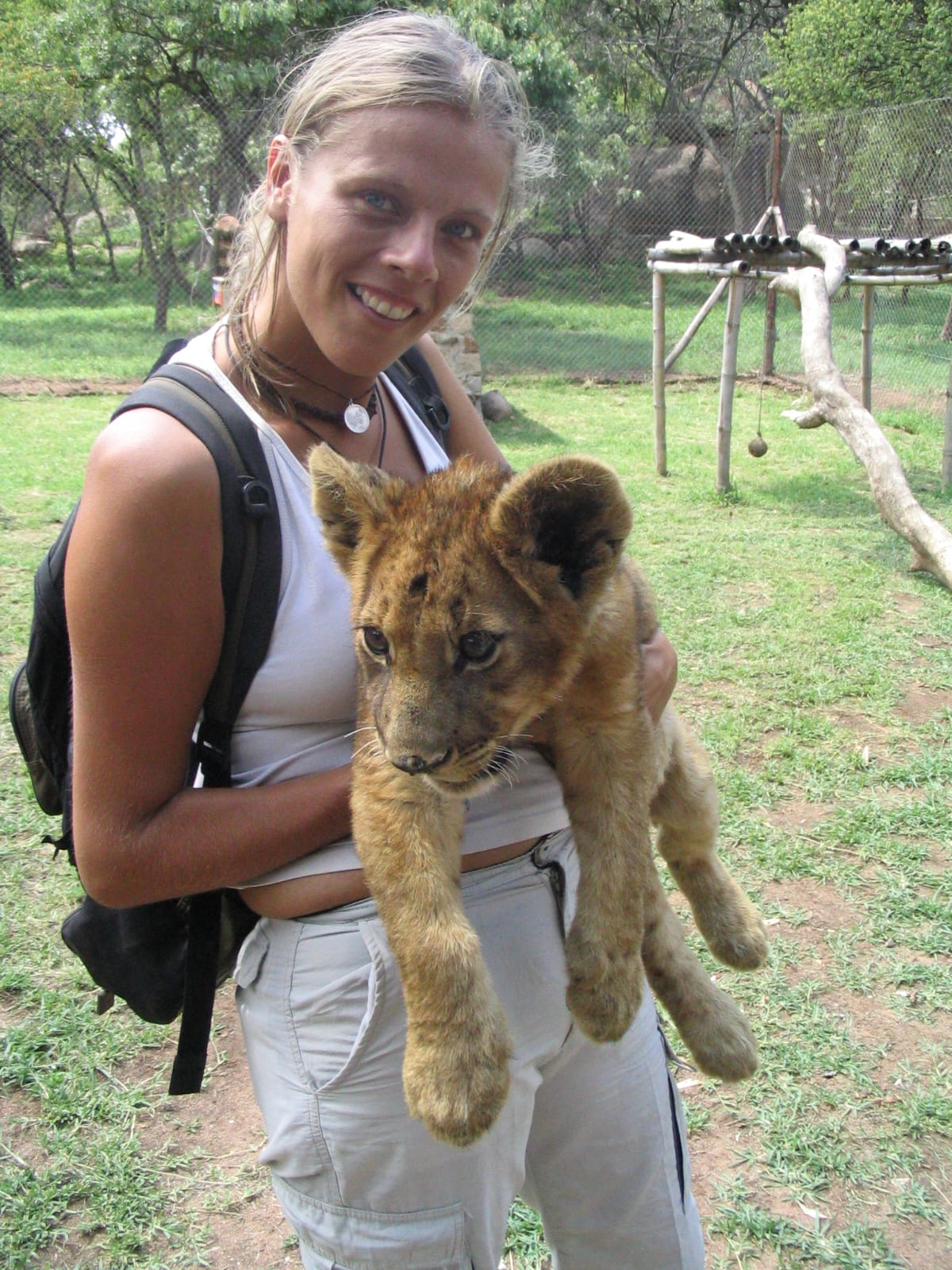
So there you have it, those are the ways to travel around Africa, and as you can see there’s a lot of transportation options.
Before you go, we highly recommend you take out travel insurance to protect yourself ahead of your trip.
This will protect you should you come into any unforeseen circumstances.
Don’t forget to get your travel vaccinations too and talk to your doctor about medications!
More Africa Travel Tips
Need more inspiration for traveling in Africa? Here are some other helpful guides…
- Top 5 Things in Botswana to experience the natural beauty
- 7 Reasons to visit Mozambique
- 13 awe-inspiring things to do in Eastern and Southern Africa
- Africa Travel Safety Tips
- How to travel Africa on a budget
- Safari game parks in Africa not to miss
- Africa safari tips to see the best wildlife
- Why this couple is traveling Africa and you should too
- 7 Reasons to honeymoon in South Africa
- 5 Extraordinary places to visit in Namibia